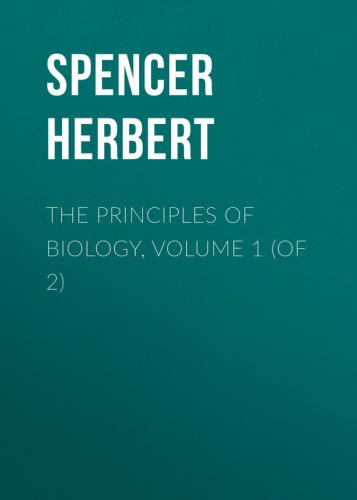Comparisons of these deductions with the facts appear in some cases to verify them and in other cases not to do so. Throughout the vegetal kingdom, there are no distinct limits to growth except those which death entails. Passing over a large proportion of plants which never exceed a comparatively small size, because they wholly or partially die down at the end of the year, and looking only at trees that annually send forth new shoots, even when their trunks are hollowed by decay; we may ask – How does growth happen here to be unlimited? The answer is, that plants are only accumulators: they are in no very appreciable degree expenders. As they do not undergo waste there is no reason why their growth should be arrested by the equilibration of assimilation and waste. Again, among animals there are sufficient reasons why the correspondence cannot be more than approximate. Besides the fact above noted, that there are other varying relations which complicate the chief one. We must bear in mind that the bodies compared are not truly similar: the proportions of trunk to limbs and trunk to head, vary considerably. The comparison is still more seriously vitiated by the inconstant ratio between the constituents of which the body is composed. In the flesh of adult mammalia, water forms from 68 to 71 per cent., organic substance from 24 to 28 per cent., and inorganic substance from 3 to 5 per cent.; whereas in the fœtal state, the water amounts to 87 per cent., and the solid organic constituents to only 11 per cent. Clearly this change from a state in which the force-evolving matter forms one-tenth of the whole, to a state in which it forms two and a half tenths, must greatly interfere with the parallelism between the actual and the theoretical progression. Yet another difficulty may come under notice. The crocodile is said to grow as long as it lives; and there appears reason to think that some predaceous fishes, such as the pike, do the same. That these animals of comparatively high organization have no definite limits of growth, is, however, an exceptional fact due to the exceptional non-fulfilment of those conditions which entail limitation. What kind of life does a crocodile lead? It is a cold-blooded, or almost cold-blooded, creature; that is, it expends very little for the maintenance of heat. It is habitually inert: not usually chasing prey but lying in wait for it; and undergoes considerable exertion only during its occasional brief contests with prey. Such other exertion as is, at intervals, needful for moving from place to place, is rendered small by the small difference between the animal's specific gravity and that of water. Thus the crocodile expends in muscular action an amount of force that is insignificant compared with the force commonly expended by land-animals. Hence its habitual assimilation is diminished much less than usual by habitual waste; and beginning with an excessive disproportion between the two, it is quite possible for the one never quite to lose its advance over the other while life continues. On looking closer into such cases as this and that of the pike, which is similarly cold-blooded, similarly lies in wait, and is similarly able to obtain larger and larger kinds of prey as it increases in size; we discover a further reason for this absence of a definite limit. To overcome gravitative force the creature has not to expend a muscular power that is large at the outset, and increases as the cubes of its dimensions: its dense medium supports it. The exceptional continuance of growth observed in creatures so circumstanced, is therefore perfectly explicable.
§ 46a. If we go back upon the conclusions set forth in the preceding section, we find that from some of them may be drawn instructive corollaries respecting the limiting sizes of creatures inhabiting different media. More especially I refer to those varying proportions between mass and stress from which, as we have seen, there results, along with increasing size, a diminishing power of mechanical self-support: a relation illustrated in its simplest form by the contrast between a dew-drop, which can retain its spheroidal form, and the spread-out mass of water which results when many dew-drops run together. The largest bird that flies (the argument excludes birds which do not fly) is the Condor, which reaches a weight of from 30 to 40 lbs. Why does there not exist a bird of the size of an elephant? Supposing its habits to be carnivorous, it would have many advantages in obtaining prey: mammals would be at its mercy. Evidently the reason is one which has been pointed out – the reason that while the weight to be raised and kept in the air by a bird increases as the cubes of its dimensions, the ability of its bones and muscles to resist the strains which flight necessitates, increases only as the squares of the dimensions. Though, could the muscles withstand any tensile strain they were subject to, the power like the weight might increase with the cubes, yet since the texture of muscle is such that beyond a certain strain it tears, it results that there is soon reached a size at which flight becomes impossible: the structures must give way. In a preceding paragraph the limit to the size of flying creatures was ascribed to the greater physiological cost of the energy required; but it seems probable that the mechanical obstacle here pointed out has a larger share in determining the limit.
In a kindred manner there results a limitation of growth in a land-animal, which does not exist for an animal living in the water. If, after comparing the agile movements of a dog with those of a cow, the great weight of which obviously prevents agility; or if, after observing the swaying flesh of an elephant as it walks along, we
